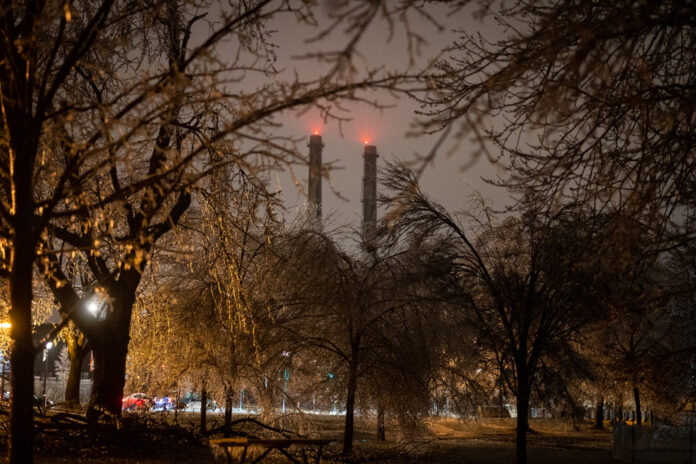More than a million Hydro-Quebec customers without power, 300 fallen trees and 1,500 broken or threatening branches in Montreal: Southwestern Quebec was hit hard by the freezing rain that fell at the end of day Wednesday. The cleaning operation will take several days and many schools will be closed this Thursday in the metropolis.
As of 6:15 a.m. Thursday, Hydro-Quebec counted 1,091,782 customers without electricity in the province. In Montreal, Montérégie and Outaouais, the three most affected regions, there were 808,000 total subscribers in the dark.
In the latter region, where 30mm of freezing rain fell, more than half of the state-owned company’s customers were without power at times. In Montreal, at the height of the ice storm, the proportion reached nearly one in two households.
For the number of outages recorded, this event would be one of the largest since the infamous ice storm of 1998, when a total of 88.5 to 98.5 mm of freezing rain was recorded in the southwest of Quebec in the space of four days.
The accumulations of freezing rain on Wednesday, of the order of 15 to 25 mm depending on the sectors of the Montreal region, are however much less.
Despite everything, on the Plateau Mont-Royal, many streets were plunged into darkness. Cars were driving there between the many tree branches that had fallen on the road.
The strange stillness of these scenes was broken at a steady pace by the dull creak of huge branches falling to the ground, as La Presse saw in La Fontaine and Laurier parks.
“It’s beautiful, but to hear the trees falling, it’s a bit apocalyptic,” describes Colline Blanc, who went out for a walk with her partner to kill time between now and the return of electricity to her home.
“Usually I go through the park to get home, but there, out of the question,” exclaimed for his part Jason Cappelle, crossed on Parc-La Fontaine Avenue, where at least one car had been crushed by a tree branch.
And this car was probably not the only one in this situation given the potentially record number of 300 fallen trees reported to the 311 service, which was “very tested” according to the administrative spokesperson for the City of Montreal. , Philippe Sabourin. Additionally, 1500 branches were reported as broken or threatening.
In comparison, the violent fall storm of November 1, 2019 knocked down 250 trees, but only 300 branches, he recalled.
“We have hundreds of municipal employees who are currently working on the ground and who will remain mobilized until the situation is resolved”, assured Mr. Sabourin. However, if the time to clear public roads was calculated in “hours”, according to him, the work necessary to secure all the trees in Montreal could take several days.
While many traffic lights were non-functional on Wednesday, Mr. Sabourin urged motorists to be extremely careful. “It’s really important to bring the vehicle to a complete stop and then really look all around,” he insists.
It also implores citizens to avoid urban forests or any other covered areas where they risk experiencing falling branches or entire trees. “As long as we have not been validated on the ground, that we have not taken measures to secure the premises, we ask people to avoid walking there. »
Finally, Mr. Sabourin calls on Montrealers to dial 311 only in case of essential need. “Is the sidewalk blocked, is the street blocked? If the answer is no, maybe it’s something that could wait,” he gives as an example.
The school service centers of Montreal (CSSDM), Marguerite-Bourgeoys and Pointe-de-l’Île and the English-Montreal school board had already announced on Wednesday that all their establishments would be closed this Thursday.
The CSSDM cited in particular the “power outages affecting many of its buildings” and “the uncertainty as to the restoration of service by Hydro-Québec”.
No course or distance learning is planned for all primary, secondary and adult students. Only staff in essential services will have to perform work, face-to-face or telework.
The 911 emergency center is currently receiving “a high volume of calls related to the ice storm,” the Montreal Police Service said on Twitter late Wednesday afternoon. “To report the damage to your insurer, no police report is required. If a situation endangers safety or traffic, contact 911 immediately.
Gabrielle Leblanc, spokesperson for Hydro-Québec, assured Wednesday that teams were at work “in the field”, but that the weather conditions were difficult for the technicians.
“There are broken branches, affected wires. It was the combo of precipitation with the wind that caused the breaks in the network, “she said.
Late Wednesday evening, the Minister responsible for the Metropolis and the Montreal region, Pierre Fitzgibbon, indicated that he was closely monitoring “the situation related to breakdowns”. He intended to take stock of the situation from the National Assembly, in Quebec, with his colleague François Bonnardel, Minister of Public Security, around 9 a.m. this Thursday.
Meteorologist at Environment Canada, André Cantin reminds us that this icy phenomenon is not exceptional at the beginning of April. But, according to him, it is most likely the last whiff of winter.
“Sunshine can be expected thereafter,” he said, “with rising mercury, temperatures reaching 15 or even 20 degrees by the middle of next week. »
By late Wednesday evening, Environment Canada was forecasting rising temperatures of up to 9°C overnight and, for Thursday morning, intermittent rain ending by midday.
Temperatures should then remain stable near 9°C, which would cause the ice to disappear as quickly as it appeared, although the damage it caused may still be visible for a long time.


















